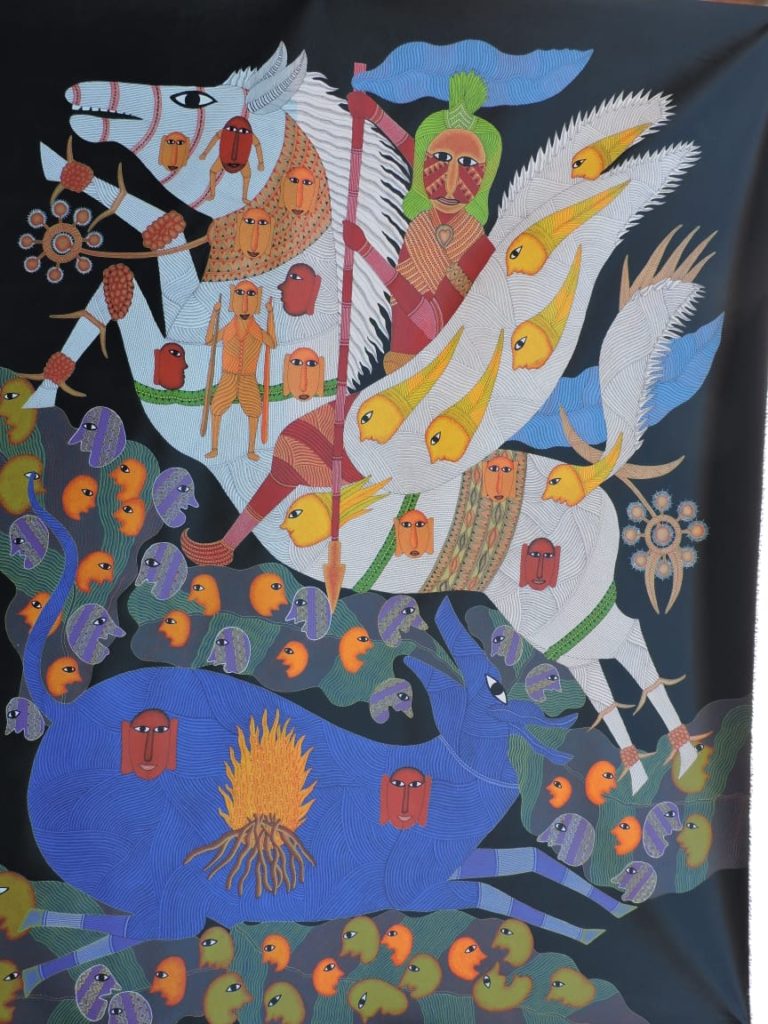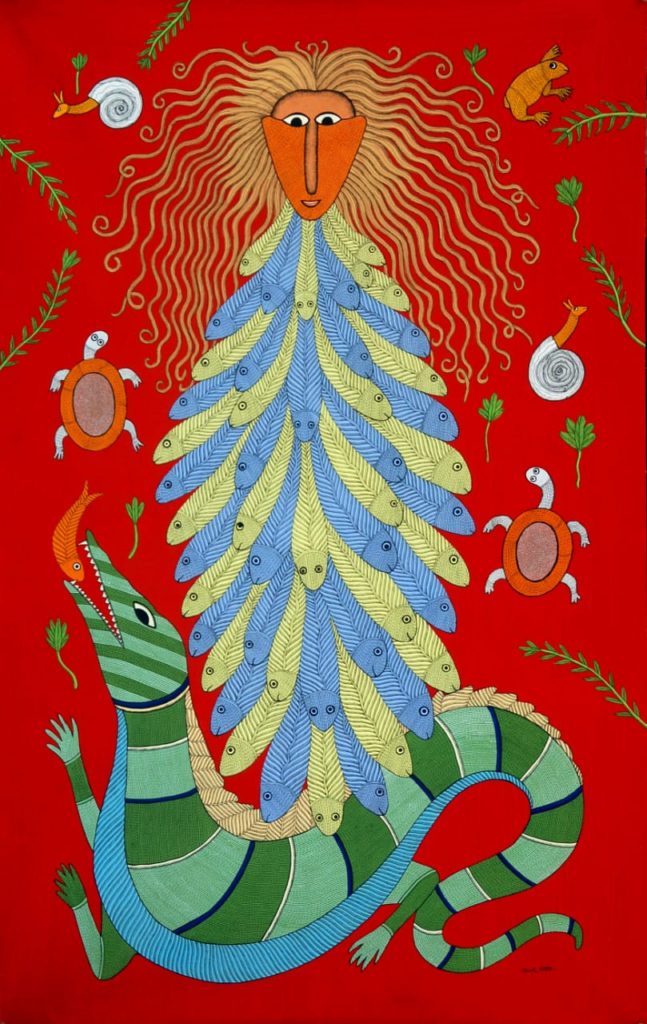
This is an unusual horse, unlike other horses. It is the horse of the Gond kings, from the time when they used to rule some thousands of years ago. At that time, there used to be shaktiyān (powers) and tantra-mantra (occult arts). The horses possessed powers, had wings and used to fly. The horse rider, in the painting, is the Gond king. Below, near the border, is a pig – a golden pig (though painted blue here). The golden pig lives on the border between two kingdoms. Back then, the kings had to fight – engage in a war – against each other to capture other kingdoms. One could win over other kingdoms only by using their shakti and tantra-mantra. Tempted by its ‘preciousness,’ the kings try to capture it, but the pig always defeats them. The golden pig, on the other hand, becomes even more powerful with every encounter and victory. Using tantra, he wins over them and absorbs their powers. Then, a Gond king – an Adivasi king – comes flying and appears in the picture. He is more powerful than the golden pig. The wings signify that power. So, at night, the deities in the Gond king’s body befriend the deities residing in the golden pig’s body and, eventually, they enter inside the latter’s body. After entering, they set the golden pig’s body on fire from within using tantra-mantra, following which, the deities who earlier resided in the golden pig’s body exit its body through various openings, like mouth and ears, and are set free.
The Goddess of Water

This is Jalhārin Mātā, the Goddess of water. When we [the Gonds] enter a water body, we pray to her for protection. If we have to cross a river, we have to swim from one bank to another. The water is quite deep, and sometimes, the river gets flooded. But one has to cross it anyway because often the village is located on one side of the river and the forest on the other. When you go to the forest to collect wood, you never know if it will start raining and the river will flood. So, whenever we are going to the forest, the river, or the canal, we bow to her before doing so. Jalhārin Mātā lives under water and protects us.
According to popular legend, the Earth had only water at first. There were no trees, no animals, no humans; just water everywhere. One day, Lord Shiva, referred to as Badā Dēv (Supreme Deity) by the Gonds, dreamt about creating life on Earth. To do this, he descended into the water and sat on a lotus leaf. He rubbed the dirt off his skin and created a crow which was blue in colour, like Shiva himself. The crow was sent off to find earth, and after flying for hundreds or thousands of miles, the crow finally spotted a wooden peg in the water. However, this wooden peg was actually Nāg Dēvtā, the serpent God. Not knowing this, the crow sat on it’s head, got bit, and turned black. The now black-coloured crow, blessed by the Lord, didn’t die.
He was then sent to find Kēkadā Mal-kshatrī, the crab. The crab would keep his claws in Ākāsh Lōk (the sky or heaven), legs in Pātāl Lōk (hell), and the torso in between, in the sea. On finding the crab, the crow announced that the Lord has asked for its help to find earth, since it hides inside the holes of the earth. The crab took the crow to Pātāl Lōk where the latter met Nīl Rājā and Nīl Rānī, the king and queen of earthworms. A long time ago, in a previous era, the Lord had gifted the earth to the earthworms and they used to eat it. The crow, destined to bring the earth back, raged a war against the earthworms who were not willing to give the earth back as they had eaten it.
Amidst this, Nīl Rānī, the queen of earthworms, swallowed all the twelve balls of the earth. Following that, the crab stifled her neck, as a result of which the neck of earthworms got thinner. Whatever Nīl Rānī hadn’t swallowed yet, the crab and crow brought it back to the Lord. The Lord churned it like curd. Then he applied it over water in layers. A Dīgnā was made where there are crops in one, rocks in another, while there’s soil in one and something else is another. This is how an Earth with 14 sections was made, wherein there’s gold in one, silver is another, and there are forests, there are rivers, etc. So we, the Gond-Pradhaan tribe, imagine the world like this – in 14 sections.

When the Lord applied the coating over water, layer by layer, it was getting dark for Jalhārin Mātā. Consequently, a worm found on the sea-shore was tearing the earth apart. When the Lord saw that someone was tearing the earth apart, which he was creating with so much effort, he angrily threw the worms in the water. In the water, the worm appears as Jalhārin Mātā.
Apart from stories, some paintings of Bhajju Shyam also depict different instances of life and aesthetics. View the gallery below for a glimpse









